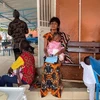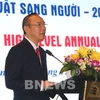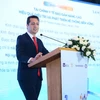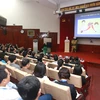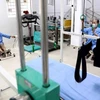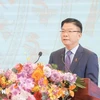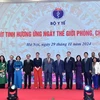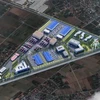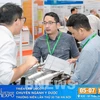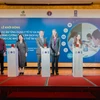A blood donation campaign across Vietnam, titled “Red Journey”, received more than 1,500 donors during its stop in Ho Chi Minh City on July 9.
Within the day, approximately 1,200 blood units were collected.
After three years of taking part in the national campaign, Ho Chi Minh City leads the nation in the rate of people involved and the blood volume of more than 350 millilitres per person on average.
Since the beginning of 2015, the southern hub has mobilised over 100,000 blood units from 84,000 volunteers, realising 46 percent of its plan for the year.
Previously, travel through the Mekong Delta provinces of Ca Mau and Bac Lieu, and Can Tho City brought almost 2,000 units to the programme.
The last stop will be in Hanoi on July 24.
The Red Journey began in 2013 alongside with an activity to raise public awareness about thalassemia, a form of inherited blood disorder that destroys a large number of red blood cells and can lead to anaemia. Nearly 29,000 units were donated at this campaign in the past two years.
According to Bach Quoc Khanh, Deputy Director of the National Institute of Haematology and Blood Transfusion, the number of blood donors has been on the rise in Vietnam in recent years. In 2014, the country amassed about 1 million blood units, 90 percent of which came from volunteers.-VNA
Within the day, approximately 1,200 blood units were collected.
After three years of taking part in the national campaign, Ho Chi Minh City leads the nation in the rate of people involved and the blood volume of more than 350 millilitres per person on average.
Since the beginning of 2015, the southern hub has mobilised over 100,000 blood units from 84,000 volunteers, realising 46 percent of its plan for the year.
Previously, travel through the Mekong Delta provinces of Ca Mau and Bac Lieu, and Can Tho City brought almost 2,000 units to the programme.
The last stop will be in Hanoi on July 24.
The Red Journey began in 2013 alongside with an activity to raise public awareness about thalassemia, a form of inherited blood disorder that destroys a large number of red blood cells and can lead to anaemia. Nearly 29,000 units were donated at this campaign in the past two years.
According to Bach Quoc Khanh, Deputy Director of the National Institute of Haematology and Blood Transfusion, the number of blood donors has been on the rise in Vietnam in recent years. In 2014, the country amassed about 1 million blood units, 90 percent of which came from volunteers.-VNA
